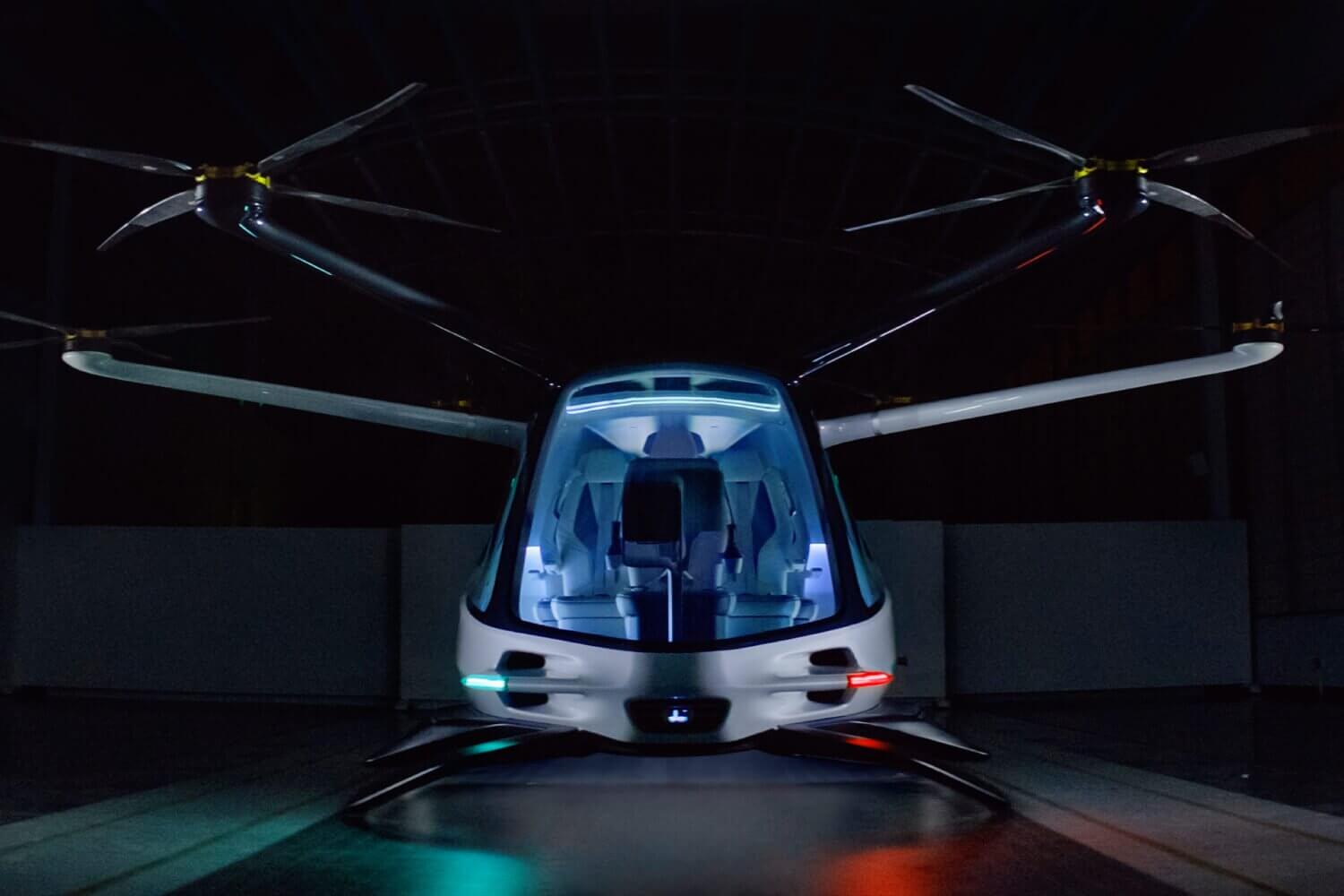Alaka’i Technologies is betting a new multicopter using challenging liquid hydrogen for fuel will carve out a niche and bring it financial success in an eVTOL aircraft marketplace.
Hydrogen has long existed as a fuel for forklifts and motor vehicles, but has yet to be successfully implemented in aviation. It is less efficient as a fuel source than traditional energy-dense jet fuel and is less convenient to handle, Dan Patt, a senior fellow at the Hudson Institute think tank in Washington, D.C., told Vertical.
Liquid hydrogen has little existing infrastructure to transport to the aircraft and store on the ground. Liquid hydrogen is also very expensive to use because it requires complex storage systems to account for cold cryogenic temperatures and requires redundancy in aircraft systems for safety.
“Is it worth this complexity and all this investment in the infrastructure to get no carbon emissions?” Patt said.
But liquid hydrogen has performance advantages over the battery electric energy being used by higher profile and more advanced eVTOL competitors. Andrew Mearns, a sales coach and consultant with Multicopter Aerospace Consulting, told Vertical that liquid hydrogen provides better range and flight duration than lithium-ion batteries, allowing better safety and opening up markets unavailable to battery-operated rotorcraft.
Rotary-wing vehicles powered by liquid hydrogen lack heavy batteries, allowing operators to carry additional payload. Liquid hydrogen aircraft also have faster recharge, or refueling, cycles than battery-powered aircraft. But Patt said batteries are much simpler than liquid hydrogen, which is why many eVTOL developers are using it for short-range air taxi missions.
Most importantly, liquid hydrogen has zero carbon emissions, producing only water vapor as a byproduct. The desire to develop a carbon-free technology source has attracted billions of U.S. dollars in investment from the U.S. federal government to develop a clean, non-polluting energy source.
Building a hydrogen VTOL platform
Alaka’i’s Skai aircraft is a six-rotor platform that is expected to have a flight duration of up to four hours and a 1,000-pound (454-kilogram) payload capacity. Alaka’i predicts the Skai will refuel in less than 10 minutes.
Hugh Kelly, Alaka’i head of marketing, told Vertical that the company is planning for a range of 200 miles (322 kilometers) on its first Skai iteration. Longer routes of up to an hour, he said, will attract revenue because competing eVTOL aircraft are offering ranges of just over 100 mi (161 km) on a full charge.
Archer, an eVTOL developer using lithium-ion batteries, is marketing its Midnight aircraft as flying rapid back-to-back flights of around 10 to 50 mi (16 to 80 km) with minimal charge time in between. Mearns said the additional range provided by liquid hydrogen aircraft will allow them to avoid poor weather or choose alternative landing sites in unforeseen circumstances.
Alaka’i expects the Skai’s cost per flight hour to initially be around 10% less than comparable battery-powered aircraft, and eventually be around 20 to 30% less. Kelly said the company expects the proliferation of hydrogen fuel cell technology in aviation and investment from the U.S. federal government to further grow that cost per flight hour gulf between liquid hydrogen and lithium-ion battery-powered aircraft.
Additionally, Kelly said lithium-ion batteries have already experienced the bulk of its price reduction and that a new technology, such as solid state, will be required to drop that price even further.
The U.S. Department of Energy (DOE) has made available US$7 billion to launch seven Regional Clean Hydrogen Hubs (H2Hubs) across the nation. This is expected to start a national network of hydrogen producers, consumers and connective infrastructure while supporting the production, storage delivery and end-use of hydrogen. The Inflation Reduction Act of 2022 also provided green hydrogen subsidies of up to US$3 per kg.
“When you combine those two things, you are going to see the transport … and production costs drop,” Kelly said.
Alaka’i is using proton exchange membrane (PEM), or polymer electrolyte membrane, for its hydrogen fuel cells. Kelly said Alaka’i specifically picked PEM for its energy density and because it is a mainstream technology.
The company did not want something so specialized it could not eventually take advantage of economies of scale. Fuel cells based on PEMs are among the most promising due to their high efficiency, high power density, low emissions and energy supply.
Alaka’i is also outsourcing its hydrogen fuel cells and is finalizing testing on several options. Kelly declined to say which company Alaka’i will procure its hydrogen fuel cells from because it is still in negotiations.
Alaka’i has three Skai prototypes: An initial build that serves a utility similar to a demonstration unit and two aircraft for actual test flights. Kelly said flight tests have been limited since December due to the winter weather in Stow, Massachusetts, but Alaka’i is now flying multiple times per week.
The company has been focusing its flight testing, which is remotely-piloted, on making sure the software responds so that it resembles a helicopter to a pilot as much as possible. Alaka’i declined to say how many hours the Skai has in flight tests.
Addressing the hydrogen challenge
Complex storage issues make using liquid hydrogen for aircraft fuel a challenge as Patt said it has to be stored in extraordinarily strong tanks that keep the fuel at cryogenic temperatures. Liquid hydrogen’s boiling point, where it changes from liquid to a gas, is -423 degrees Fahrenheit (-253 degrees Celsius), according to the U.S. National Institute of Standards and Technology (NIST).
Operators also cannot allow liquid hydrogen to boil off or it will overpressurize the tank, requiring ventilation systems.
All this complexity adds to the aircraft’s weight, reducing payload capacity. Patt said for every 2,205 lb (1,000 kg) of traditional jet fuel used in an aircraft, users pay about a 10% penalty because of the fuel tank bladder. With liquid hydrogen, he said, the tank weighs around four to 12 times as much as the fuel being carried. Alaka’i has performed drop testing of cryogenic liquid hydrogen vessels from heights of 50 feet (15 meters).
Additionally, Patt said hydrogen fuel cells could now be close to 60% efficient. This is a big advancement compared to their traditional 40% efficiency, he said, but still represents 40% wasted fuel. This converted electricity must also be run through a set of 90 to 95% efficient power electronics and a 90 to 95% efficient electric motor.
Despite these challenges, Patt said it is noble to pursue zero carbon emissions in aviation via liquid hydrogen fuel. The skepticism, he said, is in making the business case work. Alaka’i said it has a model for how to set up a hydrogen fueling station that can be deployed anywhere in the U.S. Alaka’i plans on working with partners to build out an ecosystem to ensure its customers can use hydrogen.
Alaka’i wants to have its Skai certified for flight by 2026. Patt said U.S. Federal Aviation Administration (FAA) regulators will likely focus on the possible failure mechanisms around liquid hydrogen storage on the aircraft and how storage cascades across other aircraft systems. These include the pressure and sensor mechanisms and how Alaka’i is managing boil-off.
The FAA, he said, will want to learn how venting would impact the Skai’s range, where it can operate and where it would have a safe landing zone. The agency will also want to know if the Skai needs to supplement a powered landing with batteries or if the system can auto-rotate.
An FAA spokesman said the agency expects to see more traditional aircraft transitioning to electric, hydrogen and hybrid propulsion. The FAA has regulations in place that allow manufacturers to achieve the agency’s safety standards in innovative ways.





